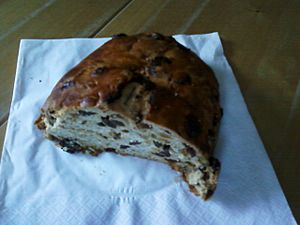Bisciola facts for kids
 |
|
| Alternative names | Panettone valtellinese, pan di fich |
|---|---|
| Type | Sweet bread |
| Place of origin | Italy |
| Region or state | Lombardia |
| Associated national cuisine | Italian |
| Serving temperature | Room temperature |
| Main ingredients | Buckwheat flour, figs, honey, raisins, and walnuts |
Bisciola is a special sweet bread from the Valtellina valley in Lombardy, Italy. It's a type of bread that uses yeast to rise, making it soft and airy. People in Italy often make and enjoy Bisciola during the Christmas holidays. It's a very important part of their Christmas celebrations!
This bread has a few other names too. Sometimes it's called panettone valtellinese, which means "panettone from Valtellina." It's also known as besciola or pan di fich. The name pan di fich comes from the local language and simply means "fig bread."
Contents
What's in a Name?
The name Bisciola probably comes from an old Latin word, buccella. This word means "morsel" or a small piece of food.
There's a fun story about how Bisciola might have started. The legend says that in 1797, a famous leader named Napoleon was visiting the Valtellina region. He asked his cook to make a sweet treat using only local ingredients. So, the cook gathered buckwheat flour, butter, dried figs, raisins, honey, and walnuts. From these ingredients, he created the first Bisciola! However, some historians say Napoleon was never actually in Valtellina.
Bisciola was originally a simple food for everyday people, not for kings or queens. Because of this, its first recipe was never written down. It's likely a very old recipe that has been passed down through families for many years.
What Does it Look Like and Taste Like?
Bisciola looks a bit "rustic," which means it has a simple, homemade appearance. It's often compared to a more traditional panettone, another famous Italian sweet bread. Bisciola is a tasty loaf that is firm and a bit crunchy. It also has a lovely smell.
Like other sweet breads from Italy, such as colomba pasquale or pandoro, Bisciola has a certain amount of moisture. This makes it soft but still firm.
People usually eat Bisciola after lunch or Christmas dinner. You can enjoy it at room temperature or slightly warm. Some people like to dip a piece of Bisciola in grappa, which is an Italian drink. It also tastes great with coffee or a sweet custard called zabaione.
How is Bisciola Made?
Making Bisciola takes time and care. It starts with a special kind of sourdough starter. This starter helps the bread rise naturally.
The bread can be made with different types of flour. Some bakers use rye flour, while others use wheat flour. Many traditional versions use buckwheat flour, which gives it a unique flavor. Other ingredients mixed into the dough include butter, milk, sugar, and yeast.
What makes Bisciola special are the delicious additions! Bakers add dried figs, honey, raisins, and walnuts to the dough. Sometimes, they might also use hazelnuts, pine nuts, almonds, or dried apricots instead.
The process of making the sourdough can take a long time, sometimes up to 36 hours! First, a "mother dough" (or starter) is mixed with flour and water. This mix sits for several hours to rise. Then, more flour and water are added, and it rises again. Finally, a small part of this dough becomes the new "mother dough" for the next batch. The rest is used to make Bisciola.
Once the dough is ready, the dried figs, raisins, and walnuts are cut into pieces and mixed in. The dough then rests for about an hour. After that, it's shaped into a loaf, brushed with an egg wash (which makes it shiny), and baked for about 40 to 50 minutes.
Special Protection for Bisciola
Bisciola is so special that it has a "Marchio Collettivo Geografico." This is like a special mark that shows where the product comes from. On June 7, 2013, a group of people from the region, including bakers, decided on the rules for Bisciola. These rules make sure that the bread is always made in the Sondrio area of Italy. They also define what ingredients must be used and how it should be made. This helps protect the traditional way of making Bisciola.
The rules ensure that anyone selling Bisciola follows the traditional methods. This means the bread you buy will always be the real, authentic Bisciola from Valtellina!

